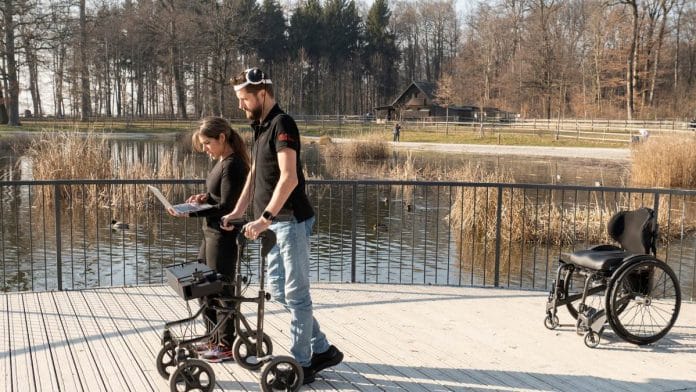New Delhi: A multinational research team of neurosurgeons and neuroscientists has developed a brain-spine interface (BSI) technology that transforms a paralysed person’s thought into action through electronic implants placed in their brain and spinal cord.
This has helped a 38-year-old volunteer regain natural control over his paralysed legs, and restored movement in his lower limbs. Gert-Jan, who suffered from tetraplegia — the inability to move lower and upper limbs — after sustaining a spinal injury in a bicycle accident, can now stand upright, walk freely, and even take the stairs.
The device was also found to improve neurological recovery as the volunteer was able to walk with crutches even when the implant was switched off. The findings of the research were published in Nature on 24 May.
Talking about how he can now share a beer with his friends while standing at a bar, Gert-Jan says, “This simple pleasure represents a significant change in my life.”
Grégoire Courtine from the Ecole Polytechnique Fédérale de Lausanne (EPFL) in Switzerland was the lead author who collaborated with researchers from France, Netherlands, Switzerland, UK and the US.
The effects of the BSI system still appear to be localised, as it has not been tested on any other parts of the spine. Moreover, it has only been tested on one person so far. “The validation of this digital bridge was restricted to a single individual with severe but partial damage of the spinal cord, and it therefore remains unclear whether the BSI will be applicable to other injury locations and severities,” the researchers wrote.
However, they are positive about their findings. Researchers Jocelyne Bloch and Grégoire Courtine explain that in the future, a comparable strategy could be implemented to restore arm and hand functions. Several developments will be required to scale up the digital bridge, but it is possible for it to be applied to other clinical conditions, such as paralysis due to stroke.
“The concept of a digital bridge between the brain and spinal cord augurs a new era in the treatment of motor deficits due to neurological disorders,” they wrote.
Also read: What 7,200-yr-old fibres from Indus Valley found in Israel tell us about cotton domestication
How BSI system fares vis-a-vis past research
A spinal cord injury interrupts the communication pathway between the brain and the neurons located in the lumbosacral spinal cord that is responsible for controlling walking. This can lead to permanent paralysis.
Researchers have previously demonstrated how electrical stimulation targeting the lumbosacral spinal cord restores basic walking and standing functions in people with paralysis.
In another approach, nerve cell stimulation using electrodes has been used in stroke patients to restore upper body movements. However, the long-term safety and efficacy of this technique is yet to be assessed.
That process required wearing motion sensors to understand the intentions of movement. In those cases, patients showed limited ability to adapt leg movements to changing terrains and demands, and movement was not as natural.
In BSI technology, a direct connection has been developed in the form of a digital bridge. The participant wears a headset embedded with two antennae to make sure the implants stay connected.
One antenna powers the implants, while the other transfers signals to a processing unit that generates online movement signals. The decoded motor intentions are turned into commands which are transferred to a software programme on the same processing unit.
The researchers tested this integrated chain of hardware and software for about a year. The BSI calibrates itself within a few minutes, and has remained reliable throughout the year, even at home without any supervision.
Implantable recorder
Neurosurgeon Jocelyne Bloch, one of the authors of the paper, said they implanted the WIMAGINE (Wireless Implantable Multi-channel Acquisition system for Generic Interface with Neurons) device above the region of the brain that is responsible for controlling leg movements.
The device is a 64-channel wireless implantable recorder that measures electrical activity. It becomes invisible once implanted in the skull. “These devices developed by the French lab CEA allow the decoding of electrical signals generated by the brain when we think about walking,” said Bloch.
They placed another neurostimulator over the region of the spinal cord that controls leg movement. The researchers then used adaptive artificial intelligence methods to understand movement intentions and decode it in real time. These intentions then electrically stimulate the spinal cord, in turn activating leg muscles to achieve the desired movement.
Across 40 sessions of testing the BSI, the volunteer showed improvements in all the conventional clinical assessments conducted by physiotherapists. From as early as the first session, he was able to move his hips. Over time, he was also able to move his hip, knee and ankle joints. Later, he was able to initiate stepping movements or walk continuously.
These included a six-minute walk test, weight-bearing capacities and the Berg Balance Scale, which consists of 14 tasks to check the balance of the patient.
Assessments revealed that the BSI did not impair, but slightly improved, overall balance abilities of the participant.
Walking quality was also assessed using the observational gait analysis scale.
The researchers also developed a BSI system that Gert-Jan could individually use at home. They created a walker with a case comprising all the components of the BSI. The participant is now able to interact with the software, and conduct the stimulation on his own.
(Edited by Smriti Sinha)
Also read: A house made of used diapers — researchers in Japan build low-cost, environment-friendly marvel






